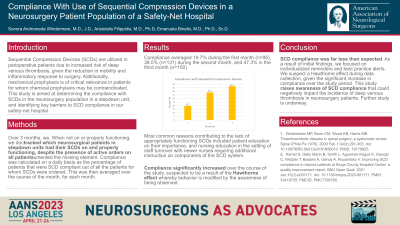Compliance With Use of Sequential Compression Devices in a Neurosurgery Patient Population of a Safety-Net Hospital
Compliance with Use of Sequential Compression Devices in a Neurosurgery Patient Population of a Safety-net Hospital
Friday, April 21, 2023


Sonora A. Windermere, MD, JD (she/her/hers)
Pre-Resident Fellow
Boston Medical Center
ePoster Presenter(s)
Introduction: Sequential Compression Devices (SCDs) are utilized in perioperative patients due to increased risk of deep venous thrombosis, given the reduction in mobility and inflammatory response to surgery. Additionally, mechanical prophylaxis is of critical relevance in patients for whom chemical prophylaxis may be contraindicated. This study is aimed at determining the compliance with SCDs in the neurosurgery population in a stepdown unit, and identifying key barriers to SCD compliance in our Safety-Net Hospital.
Methods: Over 3 months, we tracked which neurosurgical patients in stepdown units had their SCDs on and properly functioning, despite the presence of active orders on all patients. When not on or properly functioning, we documented the missing element. Compliance was calculated on a daily basis as the percentage of patients that were SCD compliant out of all the patients for whom SCDs were ordered. This was then averaged over the course of the month, for each month.
Results: Compliance averaged 19.7% during the first month (n=95), 38.5% (n=131) during the second month, and 47.3% in the third month (n=150). Most common reasons contributing to the lack of appropriately functioning SCDs included patient education on their importance, and nursing education in the setting of staff turnover with newer nurses requiring additional instruction on components of the SCD system. Compliance increased over the course of the study.
Conclusion : SCD compliance was far less than expected. As a result of initial findings, we focused on individualized reminders and best practice alerts. We suspect a Hawthorne effect during data collection, given the significant increase in compliance over the study period. This study raises awareness of SCD compliance that could negatively impact the incidence of deep venous thrombosis in neurosurgery patients. Further study is underway.
Methods: Over 3 months, we tracked which neurosurgical patients in stepdown units had their SCDs on and properly functioning, despite the presence of active orders on all patients. When not on or properly functioning, we documented the missing element. Compliance was calculated on a daily basis as the percentage of patients that were SCD compliant out of all the patients for whom SCDs were ordered. This was then averaged over the course of the month, for each month.
Results: Compliance averaged 19.7% during the first month (n=95), 38.5% (n=131) during the second month, and 47.3% in the third month (n=150). Most common reasons contributing to the lack of appropriately functioning SCDs included patient education on their importance, and nursing education in the setting of staff turnover with newer nurses requiring additional instruction on components of the SCD system. Compliance increased over the course of the study.
Conclusion : SCD compliance was far less than expected. As a result of initial findings, we focused on individualized reminders and best practice alerts. We suspect a Hawthorne effect during data collection, given the significant increase in compliance over the study period. This study raises awareness of SCD compliance that could negatively impact the incidence of deep venous thrombosis in neurosurgery patients. Further study is underway.
